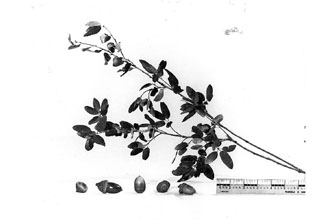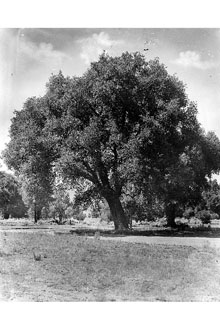Canyon Live Oak
Scientific Name: Quercus chrysolepis Liebm.

| General Information | |
|---|---|
| Usda Symbol | QUCH2 |
| Group | Dicot |
| Life Cycle | Perennial |
| Growth Habits | ShrubTree, |
| Native Locations | QUCH2 |
Plant Guide
Uses
Erosion: Canyon live oaks contribute to reducing soil loss on steep slopes, Wildlife: Canyon live oak habitat is critical to a diversity of insects, birds, and mammals. Their acorns are an important food source to birds, rodents, and deer. Other uses: Pioneers for manufacturing implements such as wagon wheels and axles prized the dense hard wood of canyon live oak. It was also used to make wedges or hammerheads for splitting redwood railroad ties.
Status
Please consult the PLANTS Web site and your State Department of Natural Resources for this plant’s current status, such as, state noxious status, and wetland indicator values.
Description
General: Canyon live oak is an evergreen tree with a rounded, dense crown, growing from 6 to 20 m tall. It also may be a low shrub in dry, open habitats. The mature bark is gray and scaly. Like all oaks, it is monoecious and wind-pollinated. Leaves are oblong to elliptic, 2 to 3 cm long, flat, firm, with entire to toothed margins. Although dark green and shiny above, their lower surfaces are paler, grayish, and covered with a yellow “felt.” Like all oaks, it is monoecious and wind-pollinated. Acorn cups are composed of thick, tubercled scales. The one-seeded nuts are 2 to 6 cm long, oblong to elliptic, and mature in less than 2 years. On average, trees have high acorn production once every 2 to 3 years. Flowering takes place from March to May. Fruits mature between August and October.
Distribution
Canyon live oak occurs in the mountains of southern Oregon, California, eastward to Arizona and New Mexico. For current distribution, please consult the Plant Profile page for this species on the PLANTS Web site.
Adaptation
Canyon live oak often occurs on moderate to steep slopes and is a common element in the mixed evergreen and conifer forests of California, ranging in elevation from 200 to 2700 m. It also is somewhat resistant to sporadic fires, often re-sprouting from the base or re-establishing from seedlings.
Establishment
Like most oaks, it has an obligate relationship with mycorrhizal fungi, which provide critical moisture and nutrients. Seedlings and saplings are shade tolerant and often occur under the canopy of older trees. Propagation by seed: Oak seeds do not store well and consequently seeds should be planted soon after maturity. Nuts are considered ripe when they separate freely from the acorn cap and fall from the tree. Care should be taken to collect local fruits, because they may be adapted to local environmental conditions. Viable nuts are green to brown and have unblemished walls. Nuts with discoloration, sticky exudates, or small holes caused by insect larvae should be discarded. Direct Seeding: Seeds may be planted at the beginning of the winter. Once a site is chosen, prepare holes that are 10 inches in diameter and 4 to 5 inches deep. One gram of a slow-release fertilizer should be placed in the bottom and covered by a small amount of soil. Place 6 to 10 acorns in each hole at a depth of 1 to 2 inches. Rodents or birds should use temporary enclosures to minimize herbivory. A simple enclosure can be constructed from a 1-quart plastic dairy container with the bottom removed and a metal screen attached. Near the end of the first season, seedlings should be thinned to 2 or 3 per hole and to 1 seedling by the second season. Supplemental watering may be necessary if a drought of 6 weeks or more occurs during the spring. Container Planting: Seeds may be planted in one-gallon containers, using well-drained potting soil that includes slow-release fertilizer. Tapered plastic planting tubes, with a volume of 10 cubic inches, also may be used. Seeds should be planted 1 to 2 inches deep and the soil kept moist. Seedlings should be transplanted as soon as the first true leaves mature. Planting holes should be at least twice as wide and deep as the container. Seedlings may require watering every 2 to 3 weeks during the first season. Care should be taken to weed and mulch around young plants until they are 6 to 10 inches tall.
Management
General: Canyon live oak is not perceived as declining throughout much of its natural range. Significant loss of habitat is unlikely since this species occurs primarily on mountain slopes and canyons on public lands. Nevertheless, where fuel loads are high, fire may cause local extirpation. However, regeneration by seeds appears to be one of the highest reported for western oaks. Cultivars, Improved and Selected Materials (and area of origin) It is best to plant species from your local area, adapted to the specific site conditions where the plants are to be grown. Contact your local Natural Resources Conservation Service (formerly Soil Conservation Service) office for more information. Look in the phone book under ”United States Government.” The Natural Resources
Conservation
Service will be listed under the subheading “Department of Agriculture.”
References
Bleier, C, 1993, Use soil moisture sensors to measure the soil moisture of Canyon Live Oak., A planner’s guide for oak woodlands, University of California Press, Berkeley, California, 94 p, Griffin, J, 1977, Oak woodland, Pages 383-415, IN M, Barbour and J, Major (eds,), Terrestrial vegetation of California, Wiley Interscience, New York, New York, Pavlik, B,M,, P,C, Muick, S, Johnson, & M, Popper 1991, Oaks of California, Cachuma Press and the California Oak Foundation, Los Olivos, California, 184 p, Schettler, S, & M, Smith 1980, Nursery propagation of California oaks, Pages 242-245, IN T, Plumb (ed,), Proceedings of the symposium on the ecology, management, and utilization of California oaks, USDA, Forest Service, Pacific Southwest Forest and Range Experiment Station, Technical Report 44,
Plant Traits
Growth Requirements
| Temperature, Minimum (°F) | 11 |
|---|---|
| Adapted to Coarse Textured Soils | Yes |
| Adapted to Fine Textured Soils | Yes |
| Adapted to Medium Textured Soils | Yes |
| Anaerobic Tolerance | None |
| CaCO3 Tolerance | None |
| Cold Stratification Required | Yes |
| Drought Tolerance | High |
| Fertility Requirement | Low |
| Fire Tolerance | Medium |
| Frost Free Days, Minimum | 160 |
| Hedge Tolerance | Low |
| Moisture Use | Medium |
| pH, Maximum | 7.5 |
| pH, Minimum | 4.5 |
| Planting Density per Acre, Maxim | 800 |
| Planting Density per Acre, Minim | 300 |
| Precipitation, Maximum | 110 |
| Precipitation, Minimum | 6 |
| Root Depth, Minimum (inches) | 42 |
| Salinity Tolerance | None |
| Shade Tolerance | Tolerant |
Morphology/Physiology
| Bloat | None |
|---|---|
| Toxicity | None |
| Resprout Ability | Yes |
| Shape and Orientation | Erect |
| Active Growth Period | Spring, Summer, Fall |
| C:N Ratio | High |
| Coppice Potential | Yes |
| Fall Conspicuous | Yes |
| Fire Resistant | No |
| Flower Color | Yellow |
| Flower Conspicuous | No |
| Foliage Color | Green |
| Foliage Porosity Summer | Dense |
| Foliage Porosity Winter | Dense |
| Foliage Texture | Medium |
| Fruit/Seed Conspicuous | Yes |
| Nitrogen Fixation | None |
| Low Growing Grass | No |
| Lifespan | Long |
| Leaf Retention | Yes |
| Known Allelopath | No |
| Height, Mature (feet) | 90.0 |
| Height at 20 Years, Maximum (fee | 30 |
| Growth Rate | Slow |
| Growth Form | Single Stem |
| Fruit/Seed Color | Brown |
Reproduction
| Vegetative Spread Rate | Slow |
|---|---|
| Small Grain | No |
| Seedling Vigor | High |
| Seed Spread Rate | Slow |
| Fruit/Seed Period End | Fall |
| Seed per Pound | 100 |
| Propagated by Tubers | No |
| Propagated by Sprigs | No |
| Propagated by Sod | No |
| Propagated by Seed | Yes |
| Propagated by Corm | No |
| Propagated by Container | Yes |
| Propagated by Bulb | No |
| Propagated by Bare Root | Yes |
| Fruit/Seed Persistence | No |
| Fruit/Seed Period Begin | Summer |
| Fruit/Seed Abundance | Medium |
| Commercial Availability | Routinely Available |
| Bloom Period | Late Spring |
| Propagated by Cuttings | No |
Suitability/Use
| Veneer Product | Yes |
|---|---|
| Pulpwood Product | No |
| Protein Potential | Medium |
| Post Product | No |
| Palatable Human | No |
| Palatable Browse Animal | Medium |
| Nursery Stock Product | Yes |
| Naval Store Product | No |
| Lumber Product | No |
| Fuelwood Product | High |
| Fodder Product | No |
| Christmas Tree Product | No |
| Berry/Nut/Seed Product | No |







